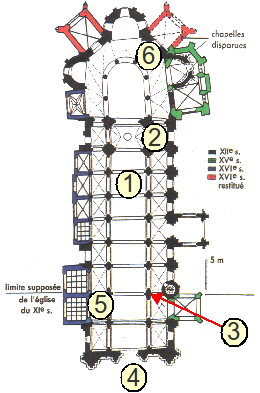 Notre Dame de la Grande is a Roman Catholic church in Poitiers. The plan of the building is in accordance with typical plans of churches of romanesque architecture of the region. It had a central nave with aisles, but no transept due to the fact that the buildings were to the north and the principal street passes to the south. The barrel vault has a slightly flattened silhouette, while the aisles were covered by a groin vault. This silhouette was removed with a gothic remodeling. During the 12th century a bell tower in the front of the church was removed and the church was increased in size. It now has a celebrated facade. Private vaults were built during the 15th and 16th centuries by the middle class of the town who were merchants since the middle ages. They were built in flamboyant gothic style.
Notre Dame de la Grande is a Roman Catholic church in Poitiers. The plan of the building is in accordance with typical plans of churches of romanesque architecture of the region. It had a central nave with aisles, but no transept due to the fact that the buildings were to the north and the principal street passes to the south. The barrel vault has a slightly flattened silhouette, while the aisles were covered by a groin vault. This silhouette was removed with a gothic remodeling. During the 12th century a bell tower in the front of the church was removed and the church was increased in size. It now has a celebrated facade. Private vaults were built during the 15th and 16th centuries by the middle class of the town who were merchants since the middle ages. They were built in flamboyant gothic style.
On the interior of the building there are many unusual detailings all over the church. The columns have patterns on them that don’t really have a uniform order to them. There were romanesque frescos that did not manage to survive other than the ones in the apse vault and above the choir. The capitols on the columns are all detailed with thick foliage, however there is just one column that tells a narrative of Jesus ascending to the heavens with angels. There are paintings at the top of the arches of the twelve apostles seated. Historians think the facade was made to resemble these paintings in the way the apostles are situated.
There is a legend in the church’s history that goes as follows: in 1202 the English attacked the town of Poitiers and asked for the town keys and in exchange they would provide the city with money. The mayor handed over the keys, but later tried to retrieve them from the captain’s quarters. He found that they key wasn’t there. The captain found out and went to the church for a miracle only to find that a statue of the virgin Mary was holding the keys. This legend hasn’t actually been confirmed with any historical evidence, however, so it’s legitimacy is questionable at best.
In 1996 the church was cleaned and restored, and is now the bright white color that it is. Damage from salt from local markets made its way up to the walls, causing it to discolor. The church is now a popular site in the town of Poitiers, France."Sacred Destinations." Notre-Dame-La-Grande - Poitiers, France. N.p., n.d. Web. 07 Dec. 2016.
Tcherikover, Anat. High Romanesque Sculpture in the Duchy of Aquitaine, C. 1090-1140. Oxford: Clarendon, 1997. Print.
No comments:
Post a Comment